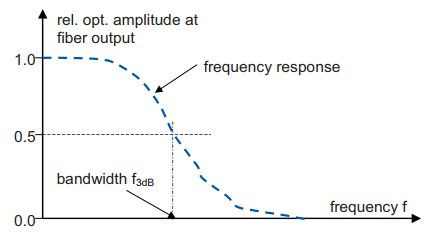Bandwidth of Optical Fiber
Bandwidth describes the range of frequencies that can be transmitted through a channel, and consequently, the rate at which data can be transmitted through it.
Bandwidth of a fiber is an important factor when designing a fiber optic transmission system. It is defined as the range of frequencies from 0 Hz (DC) to the 3 dB frequency, where the light signal has been attenuated by 3 dB, or to half the transmitter power.

The relationship between bandwidth and data rate (symbol rate) can be generalized using Nyquist’s sampling theorem. It states that in a noiseless channel with bandwidth B, the data rate R can be calculated as twice the channel’s bandwidth.

For plastic optical fiber, bandwidth is dependent on the modal dispersion of the light signal in the fiber. This is affected by wavelength of light used, the light launching conditions, the fiber’s refractive index, and the run length of the fiber. By controlling these parameters, it can be reduced to achieve a particular bandwidth or data rate.
Bandwidth is also affected by a fiber’s index profile. Graded-index POF (GI-POF) limits the number of modes transmitted better than conventional step-index POF (SI-POF) does, which has the effect of continuously guiding the light towards the center of the fiber core. This reduces modal dispersion and consequently increases the bandwidth, which is almost double that of SI-POF.
Bandwidth Measurement
Measuring the bandwidth of large core fibers is difficult, and as a result, there is no standardized definition for it or the process. Experimental measurements are carried out using highly controlled parameters, such as light launch angle and the properties of transmitters and receivers. An RF network analyzer can be used in conjunction with photodiode amplifier and device to control the light source, as seen in the following figure..

References
O. Ziemann et al., POF Handbook. Berlin, Germany: Springer-Verlag Berlin Heidelberg, 2008.